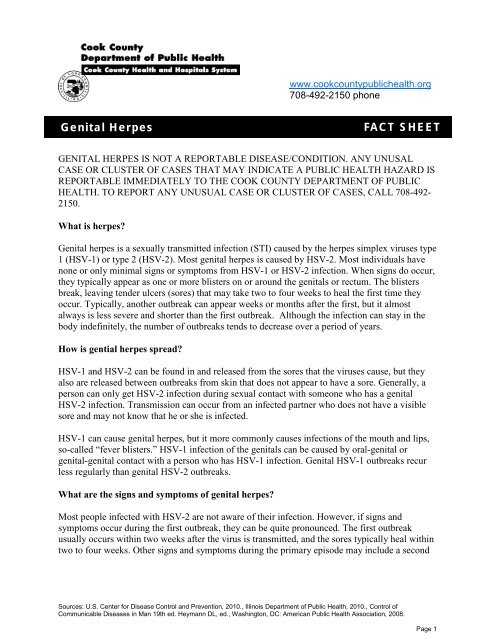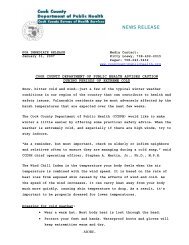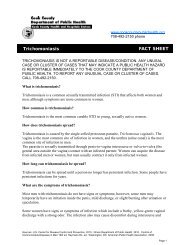Genital Herpes FACT SHEET - Cook County Department of Public ...
Genital Herpes FACT SHEET - Cook County Department of Public ...
Genital Herpes FACT SHEET - Cook County Department of Public ...
Create successful ePaper yourself
Turn your PDF publications into a flip-book with our unique Google optimized e-Paper software.
www.cookcountypublichealth.org<br />
708-492-2150 phone<br />
<strong>Genital</strong> <strong>Herpes</strong><br />
<strong>FACT</strong> <strong>SHEET</strong><br />
GENITAL HERPES IS NOT A REPORTABLE DISEASE/CONDITION. ANY UNUSAL<br />
CASE OR CLUSTER OF CASES THAT MAY INDICATE A PUBLIC HEALTH HAZARD IS<br />
REPORTABLE IMMEDIATELY TO THE COOK COUNTY DEPARTMENT OF PUBLIC<br />
HEALTH. TO REPORT ANY UNUSUAL CASE OR CLUSTER OF CASES, CALL 708-492-<br />
2150.<br />
What is herpes<br />
<strong>Genital</strong> herpes is a sexually transmitted infection (STI) caused by the herpes simplex viruses type<br />
1 (HSV-1) or type 2 (HSV-2). Most genital herpes is caused by HSV-2. Most individuals have<br />
none or only minimal signs or symptoms from HSV-1 or HSV-2 infection. When signs do occur,<br />
they typically appear as one or more blisters on or around the genitals or rectum. The blisters<br />
break, leaving tender ulcers (sores) that may take two to four weeks to heal the first time they<br />
occur. Typically, another outbreak can appear weeks or months after the first, but it almost<br />
always is less severe and shorter than the first outbreak. Although the infection can stay in the<br />
body indefinitely, the number <strong>of</strong> outbreaks tends to decrease over a period <strong>of</strong> years.<br />
How is gential herpes spread<br />
HSV-1 and HSV-2 can be found in and released from the sores that the viruses cause, but they<br />
also are released between outbreaks from skin that does not appear to have a sore. Generally, a<br />
person can only get HSV-2 infection during sexual contact with someone who has a genital<br />
HSV-2 infection. Transmission can occur from an infected partner who does not have a visible<br />
sore and may not know that he or she is infected.<br />
HSV-1 can cause genital herpes, but it more commonly causes infections <strong>of</strong> the mouth and lips,<br />
so-called “fever blisters.” HSV-1 infection <strong>of</strong> the genitals can be caused by oral-genital or<br />
genital-genital contact with a person who has HSV-1 infection. <strong>Genital</strong> HSV-1 outbreaks recur<br />
less regularly than genital HSV-2 outbreaks.<br />
What are the signs and symptoms <strong>of</strong> genital herpes<br />
Most people infected with HSV-2 are not aware <strong>of</strong> their infection. However, if signs and<br />
symptoms occur during the first outbreak, they can be quite pronounced. The first outbreak<br />
usually occurs within two weeks after the virus is transmitted, and the sores typically heal within<br />
two to four weeks. Other signs and symptoms during the primary episode may include a second<br />
Sources: U.S. Center for Disease Control and Prevention, 2010., Illinois <strong>Department</strong> <strong>of</strong> <strong>Public</strong> Health, 2010., Control <strong>of</strong><br />
Communicable Diseases in Man 19th ed. Heymann DL, ed., Washington, DC: American <strong>Public</strong> Health Association, 2008.<br />
Page 1
crop <strong>of</strong> sores, and flu-like symptoms, including fever and swollen glands. However, most<br />
individuals with HSV-2 infection never have sores, or they have very mild signs that they do not<br />
even notice or that they mistake for insect bites or another skin condition.<br />
People diagnosed with a first episode <strong>of</strong> genital herpes can expect to have several (typically four<br />
or five) outbreaks (symptomatic recurrences) within a year. Over time these recurrences usually<br />
decrease in frequency. It is possible that a person becomes aware <strong>of</strong> the “first episode” years<br />
after the infection is acquired.<br />
How long after infection do symptoms appear<br />
Anywhere from 2-12 days.<br />
How long is a person with genital herpes contagious<br />
Persons with herpes may spread herpes even though they may have no symptoms. A person with<br />
genital herpes may infect others for years, possibly for his or her entire lifetime.<br />
Is there treatment for genital herpes<br />
There is no treatment that can cure herpes, but antiviral medications can shorten and prevent<br />
outbreaks during the period <strong>of</strong> time the person takes the medication. In addition, daily<br />
suppressive therapy for symptomatic herpes can reduce transmission to partners.<br />
How can herpes be prevented<br />
The surest way to avoid transmission <strong>of</strong> sexually transmitted diseases, including genital herpes,<br />
is to abstain from sexual contact, or to be in a long-term mutually monogamous relationship with<br />
a partner who has been tested and is known to be uninfected.<br />
<strong>Genital</strong> ulcer diseases can occur in both male and female genital areas that are covered or<br />
protected by a latex condom, as well as in areas that are not covered. Correct and consistent use<br />
<strong>of</strong> latex condoms can reduce the risk <strong>of</strong> genital herpes.<br />
Persons with herpes should abstain from sexual activity with uninfected partners when lesions or<br />
other symptoms <strong>of</strong> herpes are present. It is important to know that even if a person does not have<br />
any symptoms he or she can still infect sex partners. Sex partners <strong>of</strong> infected persons should be<br />
advised that they may become infected and they should use condoms to reduce the risk. Sex<br />
partners can seek testing to determine if they are infected with HSV. A positive HSV-2 blood<br />
test most likely indicates a genital herpes infection.<br />
Sources: U.S. Center for Disease Control and Prevention, 2010., Illinois <strong>Department</strong> <strong>of</strong> <strong>Public</strong> Health, 2010., Control <strong>of</strong><br />
Communicable Diseases in Man 19th ed. Heymann DL, ed., Washington, DC: American <strong>Public</strong> Health Association, 2008.<br />
CCDPH <strong>Genital</strong> herpes Fact Sheet May 2010 Page 2
















